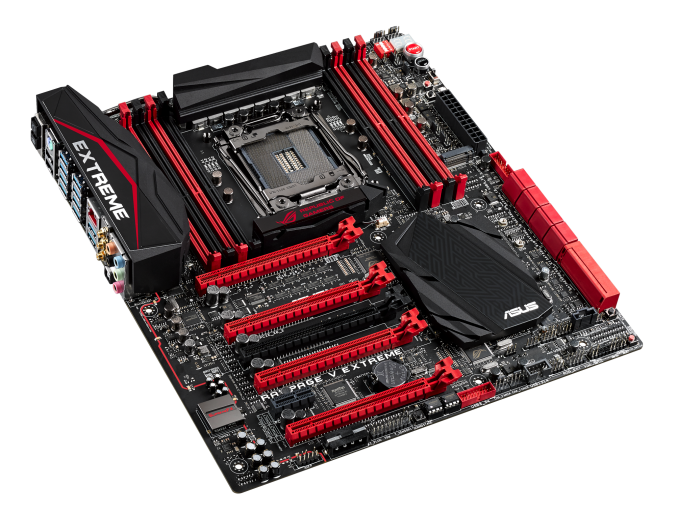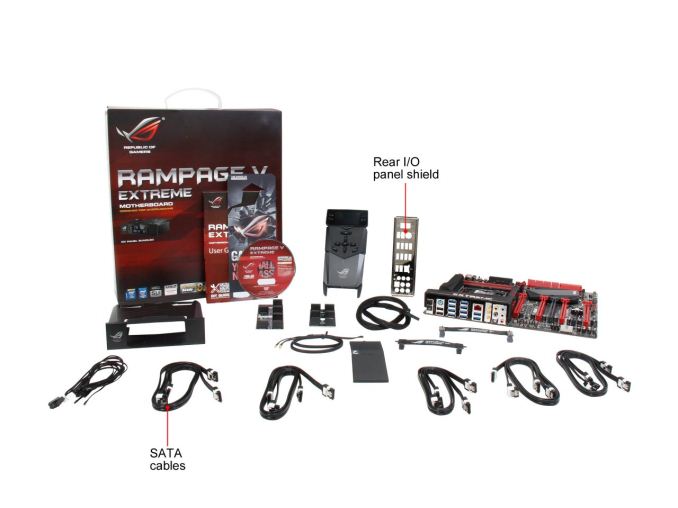The ASUS X99 Rampage V Extreme ROG Review
by Ian Cutress on June 22, 2015 8:45 AM EST- Posted in
- Motherboards
- Asus
- ROG
- Haswell-E
- X99
Conclusion
Having used the last two Extreme versions of the top of the ROG line, the Rampage IV Extreme and the Rampage IV Black Edition, it subsequently occurs perhaps the Rampage V Extreme comes across as a little underwhelming. If you've been there, seen that, it's hard to get as pumped up as the first time. The Extreme is a very good motherboard, and comes across as well engineered and with some fun stuff to play with that new users will enjoy. If you were happy with the X79 Extreme and need a comparable hardware option for X99 then the Extreme is ready to take that place. My fear is that it the Rampage V Extreme isn't as breathtaking as the X79 was.
The measure of breathtaking-ness isn't the defining feature of a motherboard however. In terms of kit we get ASUS' enhanced OC socket at the front and center, which reportedly gives better overclocking margins as well as high end memory support which we covered in our initial X99 coverage as it also featured on the X99 Deluxe. Another big feature is the use of three-stream dual band 802.11ac Wi-Fi which will aid throughput and beam forming for routers that are capable. ASUS is using tri-stream as a defining feature on the top end of its product stack, which means it is also on the Deluxe as well. To complete the trifecta, the OC Panel allows gamers to get hardware information and implement fan controls at the touch of a button while extreme overclockers can adjust voltages and frequencies on the fly.
Other features in play include eight fan headers with DC and PWM support, with four extra headers on the OC Panel, SupremeFX audio via an upgraded ALC1150 solution (PCB separation, extended EMI shield, upgraded filter caps, headphone impedance detection) as well as SoundStage and Keybot. Storage comes from the 10 SATA ports provided by the chipset as well as two more from an ASMedia controller and two SATA Express ports therein. An M.2 PCIe 3.0 x4 slot is also here for 2260, 2280 and 22110 drives, but shares bandwidth with the bottom PCIe 3.0 port in red. This has implications when multiple graphics cards are in play and SLI limitations, but the subset of M.2 users and 4-way SLI users should actually be fairly small. A total of 14 USB 3.0 ports populate the board, two from headers and ten on the rear panel from ASMedia controllers/hubs.
The BIOS and Software packages from ASUS still continue to be on the better side of interactive and informative, with the ROG packages aiming for something a little bit more than the standard. Due to the overclocking nature of the Extreme, there is the potential to get bogged down in all the overclocking options for new users. To this end there are several automatic overclocking options, both in the BIOS and software, as well as assistance through the ROG forums. Our overclocking performance showed that a mediocre CPU is still a mediocre CPU, whichever way you slice it, but good luck to those who scored nice silicon. We’ve tested the X99 Extreme up to DDR4-3333 on the latest BIOS as of testing, although our contacts at ASUS have stated that they are working on the new higher-end kits (3400 and up) to add to the QVL.
Whatever the X-Factor (or Y-Factor, or Z-Factor) is, I’m not getting the same feeling as I did from the X79 Extreme. In the words of James May of ex-Top Gear fame, there’s no fizzing root here. Part of that may be the saturation of high-end boards in the market, always going for halo, or the lack of a 4.7+ GHz overclocking CPU architecture when testing as was the case with Sandy Bridge-E and X79, but I’m not sure. It will be interesting to see the sales numbers this time around, and whether ASUS can hold that high end lead. Overall, the Rampage V Extreme continues the trend of the ROG Extreme halo series and builds on the nicely designed X99 Deluxe with an ROG garnish. For users looking for that direct, high-end upgrade from X58 or X79, it will have to be in the list for consideration.
It is also worth noting that since we received this sample, ASUS has released a USB 3.1 edition with a bundled USB 3.1 card in preparation for when the appropriate devices hit the market.












41 Comments
View All Comments
DanNeely - Monday, June 22, 2015 - link
It *IS* a standard though. The common layout you see in 99% of mobos is the one from an ATX spec from many years ago.marraco - Monday, June 22, 2015 - link
What about wifi tests?Most wifi routers reviews never care about different routers performing different with various clients, like USB dongles, integrated wifi, etc.
So, it is very important to know the performance of integrated WIFI, vs USB dongle, versus other solutions.
DanNeely - Monday, June 22, 2015 - link
IIRC where Ian lives is so built up and has so many networks fighting for limited spectrum that all you'd see is a universal faceplant if he tried to do wifi testing.arneberg - Monday, June 22, 2015 - link
Nice motherboard but i miss pci-e lanes, 2 pci-e are to little (in full x16 speed) And there should be 2 M.2 pci-e v3 x4 ports and where is the 8636 ports? otherwise a beutiful card have the x79 version myself. Ihope they come out with a updated board a x99 black maybe? I have used asus mainboards för maybe 20 years now and been wery satisfied with them but for x99 i have a asrock becouse of better features. if i could choice i rather have a asus board.arneberg - Monday, June 22, 2015 - link
Sorry for the bad english in my last post !I hope some motherboard manufacturer have the guts to take away sata express (to slow anyway for the fastest ssd ) and most of the sata ports (we may need them, now but in a few year who need it i use 1 for storing games on a ssd, the system is on a nvme disk (pci-e), and have the new 8639 ports instead. More M.2 pci-e v3 x4 ports and chip to double up the pci-e lines. then i would buy the motherboard.
aron9621 - Monday, June 22, 2015 - link
"With 40 PCIe lane CPUs, the processor supplies x16/x8/x16/- in tri-GPU mode..."The Rampage V can only handle 16x/8x/8x for three cards. The X99 Deluxe is more flexible in this regard.
B3an - Monday, June 22, 2015 - link
Couple of questions... If i had dual GPU's, and a x4 PCIe SSD (Samsung SM951) would both GPU's still run at x16?And can the SM951 be booted from on this mobo? So that an OS can be installed on it.
aron9621 - Monday, June 22, 2015 - link
That I would like to know as well. According to the manual, when you have 2x 16x cards in your system you can't use the other PCIE3.0 slots (you can, but your second card switches to 8x mode). On top of that, putting anything into the bottom slot disables the M2 slot, so it's either M2 or the last slot. It's kind of brain dead, considering how they designed the X99 Deluxe. Using the M2 slot there switches the last slot to 4x 3.0 mode, so you can use both. It also allows a 16x/16x/8x configuration (and I think it can handle 16x/16x/4x and a full speed 4x M2 slot). Of course the slot spacing on that board is less optimal than on the Rampage V, but at least it allows using a large Noctua cooler without blocking the first slot. On the other hand, running the graphic card in 8x mode doesn't hammer performance much (if at all), but still.... I wish they released a Rampage V Black Edition capable of 16x/16x/8x or 16/16/4 + the M2 slot in 4x mode.B3an - Monday, June 22, 2015 - link
It's so retarded if i can't run two GPU's at x16 with a x4 PCIe SSD attached. This is meant to be their best mobo.I wonder if the Fury X will have much of a performance hit running at x8...
ChronoBodi - Tuesday, July 7, 2015 - link
Late response and first time post here:I have two r9 290X 8GB in crossfire taking up their designated slots, and an Intel 750 SSD 1.2 TB PCI-E SSD in the 4th red slot, AND an m.2 Samsung XP941, all of them running fine at the same time.
I think it should be 16x for both GPUs and the remaining 8 lanes split into 2 sets of 4 lanes for both PCI-E SSDs.
I have to check GPU-Z later to confirm the GPUs.